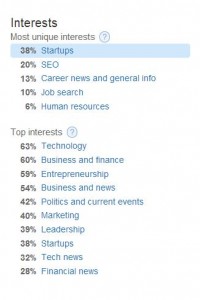Have you seen the AT&T ad where little kids posit numbers bigger than infinity? (The ad is awesome, by the way.) These days, some social media platforms have their own versions of crazy numbers.
A few examples:
- Facebook has 665 million daily active users.
- YouTube has 1 billion active users every month.
- Twitter’s active user base grew by 40 percent in the past year (to 288 million monthly active users).
In fact, Twitter is now averaging 1 billion tweets every two days according to Jenna Golden, who handles political and advocacy sales for the company.
Speaking at a recent Washington Women in PR event, Golden talked about Twitter’s promoted products (aka, advertising) and the analytics that go with them. While the analytics are pay-to-play, you can get a snapshot of your own by signing in at ads.twitter.com and clicking on analytics. Here’s a look at my followers’ interests:

Twitter is all about interests, not intimacy.
According to Golden, Twitter’s graph is based primarily on who you follow (and secondarily on your bio)—not what you tweet. For example, I tweet regularly about sports and have conversations about baseball—but my Twitter followers are mostly in the business sphere. So Twitter’s betting its ad model on the fact that it’s more valuable to have my eyeballs on business tweets than sports tweets. And they’re likely right—that I’m more likely to focus on, comment on, or check out a promoted tweet around a business topic than one around a sports topic.
It’s all about understanding your audience.
While Twitter has an interest graph, Facebook has a social graph.
Unlike Twitter’s focus on interests, Facebook’s is clearly focused on relationships. It’s about mapping your networks and mining that intimacy. Hence the term social graph.
The distinction makes a lot of sense: many people think of Twitter as a public network and Facebook as a private one (exploring public vs. private is a post for a different day), which is reflected in how and what most people share on each platform.
From a business perspective (and a marketing one too), it’s important to understand how Facebook and Twitter are leveraging the data we’re sharing and what each platform sees as its sweet spot.
Photo by photoloni (Flickr).



